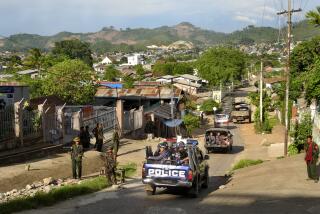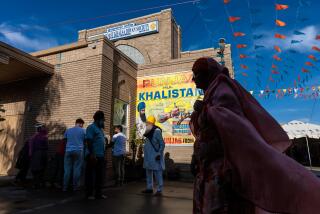Battles raging in remotest Pakistan
- Share via
peshawar, pakistan -- As Pakistani forces press ahead with their most concerted campaign in years against Taliban and Al Qaeda militants in the dry, jagged hills of Pakistan’s tribal belt, the insurgents have moved to establish new footholds in remote corners of the Texas-sized region along the border with Afghanistan.
The Islamic militants are seeking to spread their influence in areas previously untouched by fighting and are in some cases facilitating new alliances between outside groups and local insurgents, observers and officials say.
The insurgents are also increasingly employing heavy weapons and have made several brazen frontal attacks on army outposts that differed significantly from hit-and-run guerrilla-style skirmishes of the recent past.
“They’ve become better organized, more disciplined and more capable of mounting big attacks,” said Rahimullah Yusufzai, an analyst based here in Peshawar, capital of Pakistan’s North-West Frontier Province, which abuts the tribal belt.
The outcome of the Pakistani offensive will probably affect not only the course of the war in Afghanistan, where cross-border infiltration poses a serious threat to U.S. and NATO troops, but also U.S. relations with Pakistan, a key ally. President Pervez Musharraf, an army general who seized power eight years ago and is now beset by domestic political woes, has staked much of his remaining prestige on successfully confronting the insurgents.
On Sunday, Musharraf acknowledged that Islamic militants operate in his nation’s tribal areas, where they provide support to fighters in Afghanistan. The unusually candid admission came at the end of a four-day tribal meeting in Kabul, the Afghan capital.
Last week, Musharraf hinted that he might use the fighting as justification for imposing a nationwide state of emergency -- a move that would give him broad powers that could be wielded against a growing democracy movement. He backed down after objections from both the international community and broad swaths of Pakistani society, but aides said the option was still open.
The violence has been centered in North Waziristan, the most volatile of the seven Pashtun tribal areas that are described as “federally administered” but are in fact beyond the writ of Pakistan’s central government. Often-fierce clashes between Pakistani government forces and militants, coupled with suicide attacks around the country, have killed more than 250 people in the last month.
The fighting began in earnest after a 9-month-old truce between Taliban-backed tribal elders and Pakistan’s military broke down last month. Under the cease-fire, Pakistani soldiers had remained in their bases and barracks, and the militants were supposed to have evicted foreign fighters and halted infiltration-style attacks into Afghanistan.
Instead, Al Qaeda and Taliban insurgents used the hiatus to rearm and reorganize themselves, said a major U.S. intelligence report, the National Intelligence Estimate.
The Bush administration demanded action from Musharraf, who ordered a large-scale offensive in the border zone, where 90,000 Pakistani troops are said to be operating.
After weeks of clashes, it is difficult to gauge whether Pakistani forces are making much headway. No high-level Taliban or Al Qaeda figures have been reported captured or killed, although Pakistan’s government says dead combatants have included some lower-level Al Qaeda members.
Many of the armed confrontations take place in remote corners of the tribal lands, where Western journalists, and even most Pakistani outsiders, are not allowed to travel.
However, the army’s own reports from the battle zone indicate the insurgents often seize the offensive, mounting sophisticated attacks on troop convoys and military checkpoints.
As in Iraq, the insurgents make almost daily use of suicide bombings, which sometimes target civilians but are more often aimed at military and police installations. Such attacks are often thwarted, but a lone assailant can also inflict disproportionate casualties.
In response, the army, too, is changing its tactics. Like North Atlantic Treaty Organization and U.S. troops fighting insurgents in Afghanistan, Pakistani forces have made greater use of air power, chasing down militants with helicopter gunships and sometimes staging air and artillery strikes rather than exposing troops to fire by sending them into battle on foot or in lightly armored vehicles.
As coalition forces have found in Afghanistan, however, airstrikes can be an imprecise weapon, carrying the risk of heavy civilian casualties when the fighters flee into populated areas. In several recent instances in which the government has reported that militants were killed in a strike, residents have said that civilians were among the dead and wounded.
Many analysts say the Bush administration’s public exhortations for more vigorous Pakistani military action in the tribal areas have only complicated matters, uniting disparate political factions in a wave of anti-American sentiment that further weakens the already beleaguered Musharraf.
“There is the perception that the Pakistani army is the servant of the Americans, of the kafirs [nonbelievers],” said Fazul Marwat, a professor and analyst at the University of Peshawar. “This makes it difficult to sustain public support” for operations in the tribal belt.
U.S. accusations of Pakistani inaction have also infuriated field-level commanders, said retired Brig. Gen. Mahmood Shah, who oversaw Pakistani forces in the tribal areas between 2002 and 2005.
“They see their own soldiers dying almost every day, so it upsets them a lot to hear this kind of talk all the time,” Shah said. “Whatever the American administration has to say about its opinion of Pakistani military strategy, it should say privately.”
There are some indications, however, that militants are feeling the pressure. Pakistani officials say dozens of foreign fighters, including Arabs and Uzbeks, have been caught trying to flee Waziristan and make their way to the southern border province of Baluchistan.
The insurgents’ decision to establish a high-profile new presence in relatively calm regions of the tribal lands may be a feint to try to draw government forces away from Waziristan, military observers said.
Even so, the phenomenon underscores the militants’ ability to draw on a mixture of local recruits and hardened veterans of the jihad in places such as Kashmir and Chechnya.
A case in point is the village of Ghaziabad, a few miles from the Afghan border. It lies in the Mohmand tribal area, where almost no fighting has taken place during the current offensive.
Nearly a month ago, villagers took note of insurgents reconnoitering the area. The newcomers wrapped their heads in scarves that covered their faces. They carried assault rifles and drove the same Toyota pickups favored by Taliban fighters across the border.
Then one morning at the end of July, townspeople awoke to find that hundreds of masked militants had taken over the village’s only landmark of note: a shrine to a 19th century Pashtun hero of the wars against the British. Once ensconced, the insurgents did something highly unusual: They called a news conference to announce their presence -- and to essentially challenge Pakistani troops to come and get them.
Some among the group of masked militants holed up in the mosque complex speak with a local accent, said journalist Shah Nawaz Tarakzai, a Mohmand-based reporter for the Daily Ausaf newspaper. Others, he said, are Urdu speakers, apparently affiliated with militant groups from elsewhere in Pakistan. The group’s second in command told reporters he had taken part in the international jihad for the last 13 years.
Tarakzai said the group’s commander had summoned local elders to inform them that his fighters, armed with rocket launchers and heavy machine guns, would protect the village against Pakistani forces. Locals, however, are fearful that the group’s presence endangers them.
Increasingly, the militants are capitalizing on the growing sense of Pashtun nationalism in the tribal belt, seeking to fuel resentment of the country’s elite and the decision-makers in the federal capital, Islamabad, who are drawn largely from the dominant Punjabi ethnic group.
“Pashtuns feel oppressed, and they feed on that,” said Syed Alam Mahsud, a doctor from South Waziristan who is active in a Pashtun nationalist party.
Mahsud, like many other prominent professionals, was forced to flee his home area when he refused to ally himself with the insurgents and began receiving death threats. “They have hijacked our cause,” he said.
Despite their evident strengths, the militants have some serious internal disagreements, analyst Yusufzai said. Some factions, eager to avenge the storming of a radical mosque by government troops in Islamabad last month, want to wage all-out battle with Musharraf. Others want to try to patch up the truce accord so they can operate freely and concentrate on the war in Afghanistan.
Although Yusufzai and other analysts question how long the Musharraf government will be willing to sustain the campaign in the tribal areas, senior commanders insist they will see the confrontation through.
“We are succeeding,” said Pakistani military spokesman Maj. Gen. Waheed Arshad. “It may take some time, but we are certain we will prevail in the end.”
--
More to Read
Sign up for Essential California
The most important California stories and recommendations in your inbox every morning.
You may occasionally receive promotional content from the Los Angeles Times.













